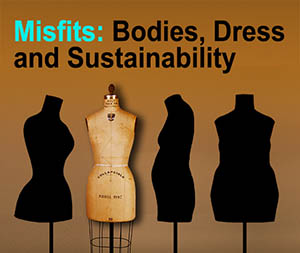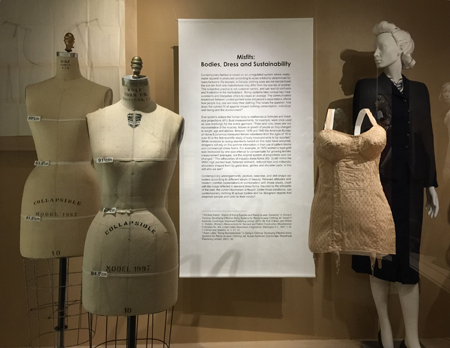

April 12 to September 13, 2017
Dr. Anne Bissonnette, Josée Chartrand, Meg Furler, Yara Sayegh and Patricia Siferd co-curators
as part of the graduate course "Material Culture and Curatorship" (HECOL 668).
Introduction Text Panel I Changing Global Bodies Text Panel I Deviant Bodies I Manifesto I Gallery Views I Press Release
Misfits: Bodies, Dress and Sustainability
Contemporary fashion is based on an unregulated system where ready-made apparel is produced according to sizes arbitrarily determined by manufacturers. For example, in Canada, clothing sizes are not standardized; the size ten from one manufacturer may differ from the size ten of another. This subjective practice is not customer-centric, and can lead to confusion and frustration in the marketplace. Sizing systems take various key measurements and interpolate others to create an average. The communication breakdown between posted garment sizes and people’s expectations affects how people buy, use and keep their clothing. This raises the question: how does the current fit of apparel impact clothing consumption, individual well-being and the environment?
Size systems reduce the human body to mathematical formulas and linear size projections. Bust measurements, for example, were once used as size markings for the entire garment.[1] Then and now, sizes are not representative of the muscles, tissues or growth of people as they changed in weight, age and abilities. Between 1939 and 1940 the American Bureau of Home Economics measured female volunteers from the ages of 18 to over 80 in the first scientific study of body measurements to be reported.[2] While revisions to sizing standards based on this data have occurred, designers still rely on this wartime information in their use of pattern blocks and commercial dress forms. For example, in 1970 women’s bust girth was increased by one size interval to compensate for growing female measurement averages, but the original system of proportions was not changed.[3] The silhouettes of industry dress forms still mimic the WWII high pointed bust, flattened stomach, reduced hips and militaristic shoulders shaped from by-gone bras, girdles and shoulder pads. Is this still who we are?
Contemporary undergarments, posture, exercise, and diet shape our bodies according to different ideals of beauty. Relaxed attitudes and modern comfort expectations in combination with those ideals, clash with the image reflected in standard dress forms. Haunted by the silhouette of the past, the current foundation is flawed. Under these conditions, can contemporary clothing fit actual bodies and be designed objects that empower people and cater to their needs?
______________
[1] Winifred Aldrich, “History of Sizing Systems and Ready-to-wear Garments,” in Sizing in Clothing: Developing Effective Sizing Systems for Ready-to-wear Clothing, ed. Susan P. Ashdown (Cambridge: Woodhead Publishing Limited, 2007), 39; Ruth O’Brien, and William C. Sheldon, Women’s Measurements for Garment and Pattern Construction, Miscellaneous Publication No. 454, United States Department of Agriculture, Washington D.C., 1941, 1, 42.
[2] O’Brien and Sheldon, iii, 1, 21, 31.
[3] Karen Labat, “Sizing Standardization,” in Sizing in Clothing: Developing Effective Sizing Systems for Ready-to-wear Clothing, ed. Susan Ashdown (Cambridge: Woodhead Publishing Limited, 2007), 95.
Cite this page (bibliography):
Bissonnette, Anne, and Josée Chartrand, Meg Furler, Yara Sayegh, Patricia Sifered. “Misfits: Bodies, Dress and Sustainability." Exhibitions, Clothing and Textiles Collection Web site, Department of Human Ecology, University of Alberta, April 12, 2017. [INSERT URL].




